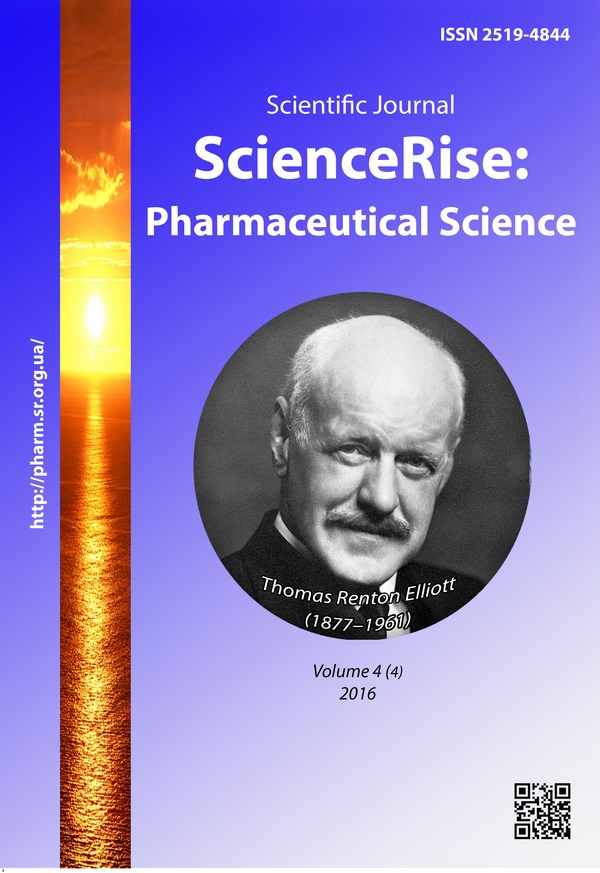Изучение антимикробных свойств иммобилизованных волокнистых n,n-дихлорсульфонамидов
DOI:
https://doi.org/10.15587/2519-4852.2016.85905Ключові слова:
иммобилизованный волокнистый N, N-дихлорсульфонамид, антибактериальные и антигрибковые свойства, активный хлор, активация, перевязочный материалАнотація
Цель: Определение антибактериального и антигрибкового действия волокнистых форм N,N-дихлорсульфонамида, иммобилизованных на сополимере стирола с дивинилбензолом.
Материалы и методы исследования: Объектом исследования явилась нетканая волокнистая форма иммобилизованного N,N-дихлорсульфонамида. Содержание активного хлора в образце материала – 16 %, толщина – 2,5 мм, поверхностная плотность – 340 г/м2.
Определение антибактериального и антигрибкового действия материала проводилось модифицированным методом «агаровых пластин» на мясо-пептонном агаре (МПА). В качестве тест-культур микроорганизмов использовались основные возбудители раневой инфекции: E. coli (АТСС 25922), S. aureus (АТСС 6538) и C. albicans (АТСС 10231). Микробная нагрузка составляла 1х107 КОЕ/мл. На незастывший МПА (при +45 °С) помещали тест-образцы материала таким образом, чтобы агар покрывал боковые стороны образцов. Далее поступали в соответствии с методикой определения антибактериального и антигрибкового действия материала стандартным методом «агаровых пластин».
Результаты и их обсуждение: В результате испытаний наблюдалась задержка роста тест-микроорганизмов вокруг опытных образцов иммобилизованного N,N-дихлорсульфонамида: 12,0 мм – для E. coli; 30,0 мм – для S. aureus; 40,0 мм – для C. albicans.
Сравнивая полученные результаты для иммобилизованного N,N-дихлорсульфонамида (II) с данными для N-хлорсульфонамида натрия (I), следует отметить, что зоны задержки роста тест-штаммов микроорганизмов для (II) больше, чем для (I). Так наибольшее увеличение зон наблюдается для грибов C. albicans – в 8 раз, микроорганизмов E. coli – в 2 раза, а S. aureus – в 1,5 раза. Полученные результаты можно объяснить тем, что в случае N,N-дихлорсульфонамида (II) при контакте с растворами аминокислот и солей аммония питательной среды (МПА) скорость выделения активного хлора выше, чем для N-хлорсульфонамида натрия (I), что и приводит к увеличению антибактериального и антигрибкового действия материала (II). Обнаруженные высокая антибактериальная и антигрибковая активности N,N-дихлорсульфонамида могут быть использованы для быстрого приготовления антимикробных растворов и изготовления перевязочного материала пролонгированного действия, защищающего раны от инфицирования на срок три и более суток. Рассматриваются и иные направления возможного использования материала. Из-за высокой активности (II) к грибам C. аlbicans, целесообразно апробировать его для лечения заболеваний кожи, вызванных грибами рода Candida. Материал также может использоваться в полевых условиях и при чрезвычайных ситуациях для антисептической обработки тела, при обеззараживании природной воды для питья и приготовления пищи.
Выводы: Антибактериальные и антигрибковые свойства нетканой формы иммобилизованного на полипропиленовом волокне N,N-дихлорсульфонамида (II) с привитым сополимером стирола и дивинилбензола определяются высокой окислительной и хлорирующей способностью, а также способностью активироваться растворами аминокислот и солей аммония питательной среды. Показатель эффективности задержки роста микроорганизмов для (II) существенно выше, чем для (I) и составляет: для S. aureus – 30,0 мм (в 1,5 раза), E. сoli – 12,0 мм (в 2 раза), C. albicans – 40,0 мм (в 8 раз). Результаты испытаний подтверждают наличие у материала (II) выраженных антимикробных свойств по отношению к вышеуказанным штаммам тест-микроорганизмовПосилання
- Weiss, S. J., Klein, R., Slivka, A., Wei, M. (1982). Chlorination of Taurine by Human Neutrophils. Journal of Clinical Investigation, 70 (3), 598–607. doi: 10.1172/jci110652
- Crew, J. R., Varilla, A., Rocas, A., Rani, A., Debabov, D. (2013). Treatment of acute necrotizing fasciitis using negative pressure wound therapy and adjunctive neutrophase irrigation under the foam. Wounds, 25 (10), 272–277.
- Stepanskiy, D. A., Kremenchutskiy, G. N., Koshevaya, I. P., Toropin, N. V., Toropin, V. N. (2014). Issledovanie antimikrobnyih svoystv rastvora natriya gipohlorita i taurina [Investigation of antimicrobial properties of sodium hypochlorite solution and taurine]. Biomedical and Biosocial Antropology, 22, 79–82.
- Sun, Yu. Yu., Luo, J. Patent 8486428 USA, MPK A61K31/785, A01N25/00. Compositions and methods for making and using acyclic N-halamine- based biocidal polumeric materials and articles. Board of pegents, the university of Texas system. – № US 11/389,968; declareted: 27.03.2006; published: 16.07.2013.
- Maddah, B., Azimi, M. (2012). Preparation of N, N-dichloropolystyrene sulfonamide nanofiber as a regenerable self-decontaminating material for protection against chemical warfare agents. International Journal of Nano Dimension, 2 (4), 253–259.
- Burmistrov, K. S., Murashevych, B. V., Toropіn, V. M., Toropіn, M. V. (2016). Zaiava №u 2016 05241 Ukraina: MPK: A61K31/00, A01P1/00, C08F8/38 Рolimernyi material z immobilizovanym aktyvnym khlorom, shcho proiavliaie antymikrobni vlastyvosti [Statement №u 2016 05241 Ukraine, IPC: A61K31/00, A01P1/00, C08F8/38 Рolymeris material with immobilized active chlorine that exhibits an antimicrobial properties].
- Toropіn, V. N., Surmasheva, Е. V., Romanenko, L. I. (2016). The study of antimicrobial properties of immobilized fibrous N-chloro sulfonamides. Current Issues in Pharmacy and Medicine: Science and Practice, 3, 54–58. doi: 10.14739/2409-2932.2016.3.77993
- Derzhavna Farmakopeia Ukrainy (2011). Derzhavne pidpryiemstvo «Ukrainskyi naukovyi farmakopeinyi tsentr yakosti likarskykh zasobiv». Kharkiv, 1 (4), 540.
- Metodicheskie ukazaniya «Metody ispytanij dezinfekcionnykh sredstv, dlya ocenki ikh bezopasnosti i e´ffektivnosti » [Disinfectants test methods for evaluation of safety and effi cacy]. (1998). Moscow.
- Abaev, Y. K. (2003). Ranevyie povyazki v hirurgii [Wound dressings in surgery]. Meditsinskie novosti, 12, 30–37.
##submission.downloads##
Опубліковано
Як цитувати
Номер
Розділ
Ліцензія
Авторське право (c) 2016 Владимир Николаевич Торопин, Константин Сергеевич Бурмистров, Елена Васильевна Сурмашева, Людмила Ивановна Романенко

Ця робота ліцензується відповідно до Creative Commons Attribution 4.0 International License.
Наше видання використовує положення про авторські права Creative Commons CC BY для журналів відкритого доступу.









